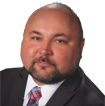Focus on Your Passion (and Culture), Not Your Paycheck

Getting it done and having fun. This month’s Corner Office profile shines on Shane Yates, CAE, CMP, executive director of the Ohio Society of Association Executives (OSAE), which has more than 500 members.
![]()
Participate in on-going education and be a lifelong learner.
Small staff organizations have to be nimble. Having clear ideas about staff, board and volunteer responsibilities is key.
Understand the trend toward “micro-volunteering.” People are so busy today, so association leaders have to be realistic about what’s expected of a volunteer.
Association Adviser: Shane, how long have you been at OSAE, and what was your background before joining the organization?
 Shane Yates: I’ve been with OSAE almost three years. Prior to join OSAE, I served as the executive director for the Ohio Physical Therapy Association. I’ve worked for member-based organizations my entire career.
Shane Yates: I’ve been with OSAE almost three years. Prior to join OSAE, I served as the executive director for the Ohio Physical Therapy Association. I’ve worked for member-based organizations my entire career.
AA: So, what’s the best part about working for an association?
SY: Two things. One is the opportunity to really advance a cause, which makes you more committed to your work and the industry your organization serves. Two, you have the opportunity to work in many different departments and roles, so that variety expands your skillset as an employee.
AA: If you’re coming from the for-profit world, what’s the biggest adjustment you need to make when working for an association?
SY: Learning how to work with volunteers. In member-based organizations, it seems the availability of key volunteers can dictate your schedule and the pace of work accomplished. You need to be flexible because volunteers in your organization are real people with real lives. They choose to share their time with your organization so you need to make the most of that time—they’re not going to fit the 9-to-5 time frame. Be prepared for using evenings and weekends to work with them.
AA: We noticed you have the CMP credential. Do you have a background in meeting planning? If so, how has that helped you in your career?
SY: My background is in training and development, which ties closely to the logistics of planning an event. Also, I firmly believe in the importance of ongoing education and being a life-long learner. I decided in 2010 that I was interested in the Certified Meeting Professional credential as a way to improve my skills and level of professionalism. It’s helped me as an executive director because the concepts and process I learned in earning my CMP translate well to managing a lot of different projects, which is certainly what you have to do in association work. The CMP isn’t so much about how many cups of coffee you need for attendees; it’s about understanding the goals and objectives of an event, how it fits within the strategic direction of an organization and how you can deliver ROI for your organization.
AA: Association Adviser’s research finds that career development is always among the hottest topics for association members. Does that surprise you?
SY: No. In today’s competitive environment, members expect their associations to make them more desirable employees. Although advancing one’s career is a member’s responsibility, associations serve a strong role in mentoring and guidance to help connect members to the proper resources and people to advance their careers. Any certification you obtain will prepare you for greater responsibilities in your job, and it will show your board (or supervisors) that you have the dedication and knowledge to be entrusted with those responsibilities.
AA: Speaking of careers, what do you tend to look for when hiring?
SY: Your resume is an indispensable part of any job search or career transition. But, I find cover letters more relevant in the interview process. Cover letters serve as a first screening, and they provide the hiring manager with an important first impression of a candidate and their communication skills. Job applicants frequently describe their strongest attributes in glowing terms, but they fail to give specific examples or illustrations that lend credibility to their statements. That’s what a good cover letter is for.
AA: Beyond careers, what are your members’ biggest concerns?
SY: They are challenged with ever-changing organizational structures, membership models and governance structures. We also hear a lot of conversations about volunteer engagement and many seem to be challenged with identifying and mentoring the next generation of volunteer leaders within their organization. And, of course, the stress of having so many last-minute registrations at all of their events.
AA: How about staffing and resource shortages?
SY: As a small staff organization, you have to be nimble. I think cutting through the red tape, having clear delineation between management role and board and volunteer role, and that separation is extremely important because it allows you as an organization to move quickly, which is what it allowed us to.
AA: Let’s talk about governance structure for a minute. Many believe your staff should be the association experts and your board the industry experts. Thoughts?
SY: The board’s role is to give direction, which it does by granting authority and setting limits. Management’s role is to execute direction, which it does by exercising that authority subject to those limits. Management operates and the board provides direction, oversight and evaluates management’s performance. I think there is an underlying tension between the two groups, which is natural and healthy, but needs to be recognized by the two. There are many things out of our control that can put an organization at-risk, but this is the most basic and easiest risk to avoid. When board members begin to do work that is outside of the governance of the organization, they are acting in the role of management.
AA: So, you’re saying staff and volunteers should be separate?
SY: No. I think there are some good opportunities to bridge the staff and volunteer dynamic. A board orientation is extremely important. Every year we go through a board orientation, and we encourage all of our organizations to do so as well. You set a bar and you set a standard. That’s kind of [association management] 101, but it’s ongoing. At all of our board meetings, we set aside an agenda item so we can talk big picture about specific things. It’s a constant reminder to our volunteers of board staff relationships and job responsibilities.
AA: Any specifics about how to do that?
SY: There are a lot of structural things we as association professionals can put in place, such as job description and board orientations. It also comes down to a level of trust. I think trust is extremely important between a board and a chief staff executive, as well as between an executive and their staff. So is communication.
AA: Tell us more about communication at OSAE.
SY: The language that we use in working with board, volunteers and staff is very important. My colleague, John Barnes, taught me to shift from a “member-driven” versus “staff-driven” organization to a more productive framework of “member-led” and “staff-implemented.” Just the simple use of the word “and” instead of the word “versus” changes the meaning and emphasizes a more collaborative and respectful environment.
AA: How about committees? Is there an ideal number to have?
SY: We used to have six or seven standing committees, but two years ago we scaled it back to three. And those are the three [committees] that really do a lot for our organization. We’ve really moved towards a work group/task force model. For example, we had a task force last year to increase our outreach within the state. We’re not focused just in one area of the state, but the entire state of Ohio. They did their work, they did their research, the legwork and then they were done. It’s important for your committees to be very focused and not to have a ton of them.
AA: So committees should be on an as-needed basis, not permanent?
SY: Well, there is the trend toward “microvolunteering.” People are so busy nowadays. We have to be realistic about what’s expected of a volunteer. They should be industry focused, not focused on minutia or other things that staff should be handling.
AA: What tips would you give to a new OSAE member who’s just embarking on their first association executive role?
SY: Right off the bat, to meet with the leadership, the board, key volunteers and get their perspective. Culture trumps everything in the association world, so it’s extremely important that a new CEO comes in and understands the culture of the organization before they start making changes. Trying to make changes without understanding the culture can be dangerous to your job.
Watch Shane Yates, Executive Director of the Ohio Society of Association Executives (OSAE) talk about how the culture of the organization dictates a lot of things.
AA: How else can you take the cultural temperature of an organization?
SY: I would encourage any association professional who has not served on a board to volunteer your time on a board because you will learn and you will understand what you’re asking from your own board members.
AA: Can a leader affect the culture of an organization or does the culture affect the leader?
I’ve worked in organizations that were not healthiest of cultures. When you look at it in the work environment culture as well, we as chief staff executives have the opportunity to create a collaborative, enjoyable and honestly fun culture. We work in a fun industry.
AA: Any final thoughts for our readers and viewers?
SY: One of the best pieces of advice I ever received was to focus on your passion, not your paycheck. We get the opportunity to not take ourselves so seriously and sometimes we need to be reminded that it’s OK to laugh or be silly. I think in association management that maturity and playfulness can coexist. That’s the great thing about associations. If we pool our collective resources, we can take a bunch of small groups and do something better. The end goal of the campaign is to show to the public the good work that the association committee in Ohio is doing.

